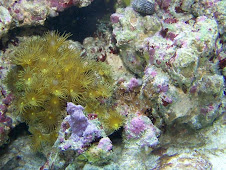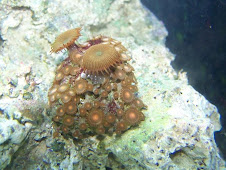
Hello and welcome to my blog on reef keeping. So you want to get into saltwater reefkeeping but don't know where to start? Lets start at the beginning.
DECIDING WHAT YOU WANT TO PUT IN YOUR TANK
A commonly overlooked place to start. There are basically four types of saltwater aquarium setup,lets go through them; 1.Fish only tank with liverock,2.Soft coral tank,3.Hard coral tank,4.Mixed reef. Each of these setups requires different types of equipment in order to be successful.
FISH ONLY WITH LIVE ROCK
The cheapest and probably easiest saltwater tank to keep,it doesn't require strong lighting or the use of a protein skimmer though depending on the ''load'' of your tank you may want to consider using a skimmer or some form of carbon filtration.
SOFT CORAL TANK
Here's a good starting point for reef keeping. You will require a stronger light than as with a fish only tank,carbon filtration,stronger current and though you still don't need a protein skimmer it's advised that one should be used in the place of a traditional filter. Also a good time to consider a sump tank which we will discuss later.
HARD CORAL/MIXED REEF
Most hard coral requires very strong lighting either t5 fluorescent or metal halide. In addition to strong lighting they require very strong flow around 20x the tank capacity per hour at the very least. A protein skimmer is an absolute must for water conditions need to be PERFECT. Some other equipment worth considering are;phosban reactors,zeovit systems ,sumps or any other equipment designed to improve water quality.
Ok now you've figured out what you want to keep,lets talk about the pieces that make it all work.
LIVE ROCK
This is the main source of filtration for a saltwater tank. The pores in the rock contain beneficial bacteria that eats the bad things in your tank such as the chemicals released in the decomposition of waste. Not to mention they host all sorts of interesting little creatures,give your fish a place to hide and something to attach corals to.
LIVE SAND (aragonite)
The same benefits as live rock,also gives burrowing fish and snails somewhere to dig.
PROTEIN SKIMMER
This will remove waste both liquid and solid entirely from your tank into a collection cup so as not to overwork the bacteria in the sand/rock.
LIGHTING
Fish only tanks can use compact fluorescent with the color rating 6500k-10000k with or without the actinic bulb(blue bulb) Soft coral can also be kept with compact fluorescent,actinic use is advised. Soft coral growth rate will be greatly increased though with the use of t5 fluorescent which is brighter. Many common species of soft coral dont do well under intense lighting,so a midrange product here would be a good way to save money.
Hard coral on the other hand require very strong light metal halide,t5 and even new technology L.E.D fixtures are most commonlly used,though LED is still a new technology which has its sceptics. Using weak lighting will cause stunted growth,color loss or browning and even death in light loving species of coral.
SUMP TANK
Kept bellow or beside the main tank and connected together via a pump and an overflow. The idea with the sump is to add aeration,give pods(live fish food)a safe place to hide and a great place to put your bulky equipment out of view. Alternating the light cycle between your display and sump also helps to stabilize your PH level.
REACTORS
A reactor is a tube filled with carbon or phosphate removal media,with a small pump to push the water through the tube. This removes anything the live rock and skimmer cant including odor. A calcium reactor efficiently puts calcium and magnesium into your tank,only practical for tanks over 100g
POWER HEADS/WAVE MAKERS
Circulation is the key and these are what you use to accomplish this. Current will help food stay up off the ground where your filtration can remove it,slows algae growth,helps some corals shed their mucous layer and helps add aeration. Current will also help your corals grow stronger.
HYDROMETER/REFRACTOMETER
Measures the amount of salt in your tank(salinity). 1.025 is ideal for a reef 1.023 is ideal for fish only.
There are many other pieces of equipment but these are the basics,in time you can make your own decision what more you would like to add.
Next post we will discuss preparing your tank for Livestock
Now you know what kind of tank you want and the equipment you need,you will have to research what goes with what,some fish eat coral and some coral eat fish lol
DECIDING WHAT YOU WANT TO PUT IN YOUR TANK
A commonly overlooked place to start. There are basically four types of saltwater aquarium setup,lets go through them; 1.Fish only tank with liverock,2.Soft coral tank,3.Hard coral tank,4.Mixed reef. Each of these setups requires different types of equipment in order to be successful.
FISH ONLY WITH LIVE ROCK
The cheapest and probably easiest saltwater tank to keep,it doesn't require strong lighting or the use of a protein skimmer though depending on the ''load'' of your tank you may want to consider using a skimmer or some form of carbon filtration.
SOFT CORAL TANK
Here's a good starting point for reef keeping. You will require a stronger light than as with a fish only tank,carbon filtration,stronger current and though you still don't need a protein skimmer it's advised that one should be used in the place of a traditional filter. Also a good time to consider a sump tank which we will discuss later.
HARD CORAL/MIXED REEF
Most hard coral requires very strong lighting either t5 fluorescent or metal halide. In addition to strong lighting they require very strong flow around 20x the tank capacity per hour at the very least. A protein skimmer is an absolute must for water conditions need to be PERFECT. Some other equipment worth considering are;phosban reactors,zeovit systems ,sumps or any other equipment designed to improve water quality.
Ok now you've figured out what you want to keep,lets talk about the pieces that make it all work.
LIVE ROCK
This is the main source of filtration for a saltwater tank. The pores in the rock contain beneficial bacteria that eats the bad things in your tank such as the chemicals released in the decomposition of waste. Not to mention they host all sorts of interesting little creatures,give your fish a place to hide and something to attach corals to.
LIVE SAND (aragonite)
The same benefits as live rock,also gives burrowing fish and snails somewhere to dig.
PROTEIN SKIMMER
This will remove waste both liquid and solid entirely from your tank into a collection cup so as not to overwork the bacteria in the sand/rock.
LIGHTING
Fish only tanks can use compact fluorescent with the color rating 6500k-10000k with or without the actinic bulb(blue bulb) Soft coral can also be kept with compact fluorescent,actinic use is advised. Soft coral growth rate will be greatly increased though with the use of t5 fluorescent which is brighter. Many common species of soft coral dont do well under intense lighting,so a midrange product here would be a good way to save money.
Hard coral on the other hand require very strong light metal halide,t5 and even new technology L.E.D fixtures are most commonlly used,though LED is still a new technology which has its sceptics. Using weak lighting will cause stunted growth,color loss or browning and even death in light loving species of coral.
SUMP TANK
Kept bellow or beside the main tank and connected together via a pump and an overflow. The idea with the sump is to add aeration,give pods(live fish food)a safe place to hide and a great place to put your bulky equipment out of view. Alternating the light cycle between your display and sump also helps to stabilize your PH level.
REACTORS
A reactor is a tube filled with carbon or phosphate removal media,with a small pump to push the water through the tube. This removes anything the live rock and skimmer cant including odor. A calcium reactor efficiently puts calcium and magnesium into your tank,only practical for tanks over 100g
POWER HEADS/WAVE MAKERS
Circulation is the key and these are what you use to accomplish this. Current will help food stay up off the ground where your filtration can remove it,slows algae growth,helps some corals shed their mucous layer and helps add aeration. Current will also help your corals grow stronger.
HYDROMETER/REFRACTOMETER
Measures the amount of salt in your tank(salinity). 1.025 is ideal for a reef 1.023 is ideal for fish only.
There are many other pieces of equipment but these are the basics,in time you can make your own decision what more you would like to add.
Next post we will discuss preparing your tank for Livestock
Now you know what kind of tank you want and the equipment you need,you will have to research what goes with what,some fish eat coral and some coral eat fish lol









No comments:
Post a Comment